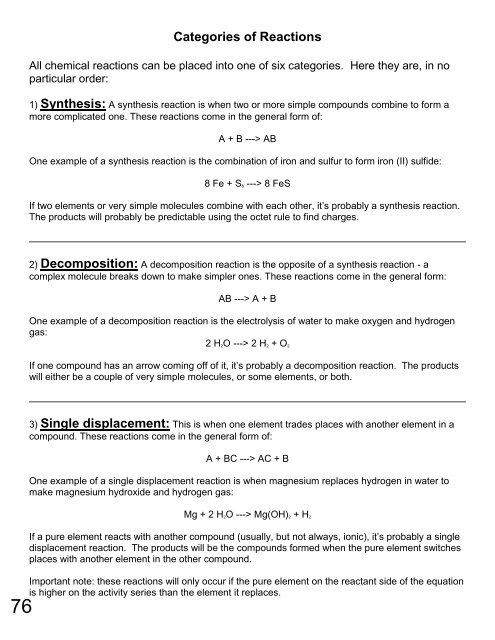Create successful ePaper yourself
Turn your PDF publications into a flip-book with our unique Google optimized e-Paper software.
Categories of Reactions<br />
All chemical reactions can be placed into one of six categories. Here they are, in no<br />
particular order:<br />
1) Synthesis: A synthesis reaction is when two or more simple compounds combine to form a<br />
more complicated one. These reactions come in the general form of:<br />
A + B ---> AB<br />
One example of a synthesis reaction is the combination of iron and sulfur to form iron (II) sulfide:<br />
8 Fe + S 8 ---> 8 FeS<br />
If two elements or very simple molecules combine with each other, it’s probably a synthesis reaction.<br />
The products will probably be predictable using the octet rule to find charges.<br />
2) Decomposition: A decomposition reaction is the opposite of a synthesis reaction - a<br />
complex molecule breaks down to make simpler ones. These reactions come in the general form:<br />
AB ---> A + B<br />
One example of a decomposition reaction is the electrolysis of water to make oxygen and hydrogen<br />
gas:<br />
2 H 2O ---> 2 H 2 + O 2<br />
If one compound has an arrow coming off of it, it’s probably a decomposition reaction. The products<br />
will either be a couple of very simple molecules, or some elements, or both.<br />
3) Single displacement: This is when one element trades places with another element in a<br />
compound. These reactions come in the general form of:<br />
A + BC ---> AC + B<br />
One example of a single displacement reaction is when magnesium replaces hydrogen in water to<br />
make magnesium hydroxide and hydrogen gas:<br />
Mg + 2 H 2O ---> Mg(OH) 2 + H 2<br />
If a pure element reacts with another compound (usually, but not always, ionic), it’s probably a single<br />
displacement reaction. The products will be the compounds formed when the pure element switches<br />
places with another element in the other compound.<br />
Important note: these reactions will only occur if the pure element on the reactant side of the equation<br />
is higher on the activity series than the element it replaces.


